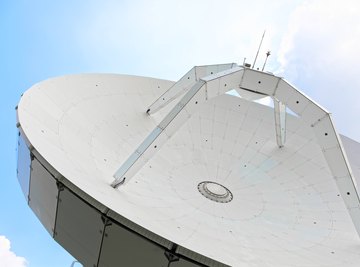
Since ancient times, humans have watched the stars in the night sky in wonder. Astronomy, the study of stars, represents one of the oldest sciences. Over time, humans developed instruments to track the stars, magnify them, and study their behavior and their contents. By trying to understand the universe, humans have learned more about their place in it.
TL;DR (Too Long; Didn't Read)
The instruments used to study stars evolved over millennia. Ancient instruments included quadrants, astrolabes, star charts and even pyramids. Optical telescopes ranged from refracting to reflecting. Radio telescopes, telescopes detecting infrared radiation, gamma rays, and X-rays and space-based telescopes are essential in modern astronomy.
Instruments in Antiquity
Ancient humans used the stars to navigate oceans, tell time and determine seasons. In ancient Egypt, pyramids were built to track the star Sirius in order to predict the Nile River’s flooding. An ancient instrument called a quadrant used spherical trigonometry to measure the altitude of a star in relation to the horizon. The armillary sphere, comprised of metal rings and using the zodiac, allowed for observation of the sky and demonstrated the movement of the stars. The astrolabe represented a multifunctional device that calculated the positions of the Sun and bright stars, and also worked as a kind of clock to tell time. Over the centuries, various cultures made star charts either to categorize stellar groups or to catalog the magnitude of stars. Astronomers also made broadsides, sheets of paper informing people about eclipses and other celestial phenomena.
The Evolution of Optical Telescopes
Optical telescopes later became the instruments of choice for observing distant stars. Refracting telescopes used two lenses, with the front lenses bending or refracting light, and an eyepiece for magnification. However, such telescopes became impractical at large sizes. Sir Isaac Newton invented a reflecting telescope that used a concave mirror for focusing light. This enabled astronomers to observe much more distant stars than before. Telescopes grew larger and more sophisticated over time. Telescope mirrors reached their upper limit in size with one primary mirror. Now, primary mirrors can be segmented to aid with the glass weight problem.
Radio Telescopes
Astronomers expanded their repertoire by using radio telescopes to detect the radio waves emitted by stars, which gives the astronomers information about stellar light wavelength. The telescopes' metal construction allows for greater size capability. Larger antennae in arrays allow for much higher resolution of radio waves.
Space Telescopes
Telescopes launched into space represent the next phase of studying stars. Space telescopes orbit the Earth but are programmed to study stars in various ways. Infrared radiation, microwave and gamma ray detection must be performed away from the atmosphere, so telescopes such as the Hubble Space Telescope have very high resolution. The Kepler Space Telescope, originally designed for exoplanet detection, granted new life in supernova (star explosion) research. Kepler and its subsequent mission K2 can focus continuously on one patch of space over a period time. This allows astronomers to follow the progression of exploding stars.
The Fermi Gamma-ray Space Telescope facilitated the detection of neutron star mergers, revealing gravitational waves in the cosmos. Cooperative ground-based observatories around the world quickly responded to try multiple forms of observations, including looking for neutron particles. Other telescopes detect X-rays, given off when neutron stars pull material into their gravity. A relatively new field of stellar astronomy involves gravitational lensing, in which space telescopes such as Hubble can observe incredibly distant stars through the natural magnifying effect of foreground galaxies.
The Influence of Astronomical Instruments
By studying the Sun, astronomers aid weather forecasters and water managers. By studying other stars, humans gain knowledge of the elements of the universe and how humans fit in. Additionally, the technology derived from modern astronomical instruments aids people in everyday life, such as in Wi-Fi, cellular phones, digital cameras, defense warning systems and GPS devices.
References
- Scientific American: Better Instruments Give Scientists a New Way to Study the Cosmos
- NASA Hubblesite: Hubble Uncovers the Farthest Star Ever Seen
- NASA Kepler and K2: Kepler Beyond Planets: Finding Exploding Stars
- California Institute of Technology: NuSTAR: Beaming With the Light of Millions of Suns
- The University of Oregon: Astronomical Instruments
- International Astronomical Union: Astronomy in Everyday Life
About the Author
J. Dianne Dotson is a science writer with a degree in zoology/ecology and evolutionary biology. She spent nine years working in laboratory and clinical research. A lifelong writer, Dianne is also a content manager and science fiction and fantasy novelist. Dianne features science as well as writing topics on her website, jdiannedotson.com.
